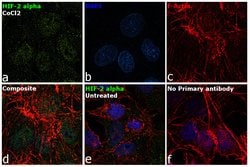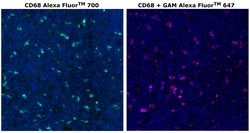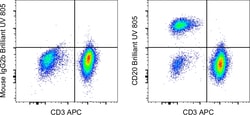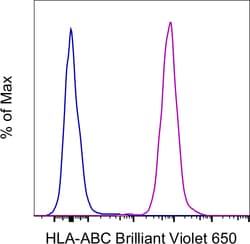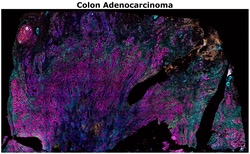
Primary Antibodies
Primary antibodies are immunoglobulins that recognize and bind to a specific antigen of interest with high affinity and specificity to purify, detect, and measure that antigen. Includes antibody pairs for specific biochemical applications.

All Primary Antibodies
(131,846)

Primary Antibody Matched Pairs
(33)

Protein Interaction Antibody Pairs
(5)

Protein Phosphorylation Antibody Pairs
(1)
Résultats de la recherche filtrée
Les produits de certains de nos fournisseurs ne s'affichent pas dans les résultats de la recherche filtrée. Veuillez
supprimer tous les filtres
pour voir ces produits.
1
–
15
de
123,319
résultats
Invitrogen™ Myogenin Recombinant Rabbit Monoclonal Antibody (JE60-39)
Rabbit Recombinant Monoclonal Antibody
| Applications | Western Blot,Immunocytochemistry |
|---|---|
| Type de produit | Antibody |
| Isotype | IgG |
| Conjugué | Unconjugated |
| Espèces cibles | Human,Mouse,Rat |
| Concentration | 1 mg/mL |
| Primaire ou secondaire | Primary |
| Forme | Liquid |
| Contenu et stockage | Store at 4°C short term. For long term storage, store at -20°C, avoiding freeze/thaw cycles. |
| État réglementaire | RUO |
| Numéro d’ordre du gène | P12979, P15173, P20428 |
| Immunogène | Synthetic peptide within human myogenin aa 1-50/224. |
| Expression | MYOG |
| Classification | Recombinant Monoclonal |
| Identification génétique (Entrez) | 17928, 29148, 4656 |
| Méthode de purification | Protein A |
| Espèces hôtes | Rabbit |
| Symboles de gène(s) | MYOG |
| Formule | TBS with 0.05% BSA, 40% glycerol and 0.05% sodium azide; pH 7.4 |
| Alias de gène | bHLHc3; Class C basic helix-loop-helix protein 3; MYF4; Myf-4; myo; MYOD1-related protein; MYOG; Myogenic factor 4; Myogenic factor-4; myogenin; myogenin (myogenic factor 4) |
| Clone | JE60-39 |
| Antigène | Myogenin |
| Applications | ELISA,Immunoprecipitation,Western Blot |
|---|---|
| Type de produit | Antibody |
| Isotype | IgG |
| Conjugué | Unconjugated |
| Espèces cibles | Human,Mouse,Rat,Bovine |
| Concentration | 0.25 mg/mL |
| Primaire ou secondaire | Primary |
| Forme | Liquid |
| Contenu et stockage | -20°C |
| État réglementaire | RUO |
| Numéro d’ordre du gène | P21856, P31150, P50396, P50398 |
| Immunogène | A 20 amino acid synthetic peptide derived from bovine brain Rab Guanine Nucleotide Dissociation Inhibitor (GDI). |
| Expression | GDI1 |
| Classification | Polyclonal |
| Identification génétique (Entrez) | 14567, 25183, 2664, 281188 |
| Méthode de purification | Antigen affinity chromatography |
| Espèces hôtes | Rabbit |
| Symboles de gène(s) | GDI1 |
| Formule | PBS with 0.1% sodium azide; pH 7.4 |
| Alias de gène | 1A; GDI1; GDI-1; GDIA; GDIalpha; GDIL; GDP dissociation inhibitor 1; GDP-dissociation inhibitor 1; GTP-binding protein; guanosine diphosphate (GDP) dissociation inhibitor 1; guanosine diphosphate dissociation inhibitor 1; mental retardation, X-linked 48; MRX41; MRX48; oligophrenin-2; OPHN2; Protein XAP-4; rab GDI alpha; Rab GDIalpha; rab GDP dissociation inhibitor alpha; rab GDP-dissociation inhibitor, alpha; RABGD RABGDIA; RABGD1A; RABGDIA; SMG p25A GDI; testis secretory sperm-binding protein Li 208a; XAP4; XAP-4 |
| Antigène | GDI1 |
| Applications | ChIP Assay,ELISA,Flow Cytometry,Gel Shift,Immunohistochemistry (Frozen),Immunohistochemistry (Paraffin),Immunoprecipitation,In vitro Assay,Western Blot,Immunocytochemistry |
|---|---|
| Type de produit | Antibody |
| Isotype | IgG |
| Conjugué | Unconjugated |
| Espèces cibles | Human,Mouse,Rat,Rabbit,Monkey,Sheep,Hamster,Fish,Reptile |
| Concentration | 1 mg/mL |
| Primaire ou secondaire | Primary |
| Forme | Liquid |
| Contenu et stockage | -20°C |
| État réglementaire | RUO |
| Numéro d’ordre du gène | P97481, Q99814, Q9JHS1 |
| Immunogène | A peptide derived from the C-terminus of mouse/human HIF-2 alpha protein. |
| Expression | EPAS1 |
| Classification | Polyclonal |
| Identification génétique (Entrez) | 100348809, 100771160, 13819, 2034, 29452, 443286 |
| Méthode de purification | Antigen Affinity Chromatography |
| Espèces hôtes | Rabbit |
| Symboles de gène(s) | EPAS1 |
| Formule | PBS with 0.05% sodium azide |
| Alias de gène | basic-helix-loop-helix-PAS protein MOP2; bHLHe73; Class E basic helix-loop-helix protein 73; ECYT4; endothelial PAS domain protein 1; endothelial PAS domain protein 1b; endothelial PAS domain-containing protein 1; endothelial PAS domain-containing protein 1b; EPAS; Epas1; EPAS-1; epas1b; Hif like protein; HIF1 alpha-like factor; HIF-1-alpha-like factor; HIF-1alpha-like factor; HIF1alpha-like factor; HIF2 alpha; HIF-2 alpha; HIF2A; hif-2a; hif-2ab; HIF-2alpha; HIF-2-alpha; HIF2-alpha; HIF-related factor; HLF; HLF (HIF1alpha-like factor); HRF; hypoxia inducible factor 2 alpha; hypoxia inducible factor 2, alpha subunit; hypoxia inducible factor 2a; hypoxia inducible transcription factor 2alpha; hypoxia-inducible factor 2 alpha; hypoxia-inducible factor 2-alpha; Member of PAS protein 2; mHLF; MOP2; PAS domain-containing protein 2; PASD2; wu:fq36f01 |
| Antigène | HIF-2 alpha |
| Applications | Immunohistochemistry (Paraffin) |
|---|---|
| Type de produit | Antibody |
| Isotype | IgG1 κ |
| Conjugué | Alexa Fluor 700 |
| Espèces cibles | Human |
| Concentration | 0.2 mg/mL |
| Primaire ou secondaire | Primary |
| Forme | Liquid |
| Contenu et stockage | 4°C, store in dark |
| État réglementaire | RUO |
| Numéro d’ordre du gène | P34810 |
| Expression | Cd68 |
| Classification | Monoclonal |
| Identification génétique (Entrez) | 968 |
| Méthode de purification | Affinity chromatography |
| Espèces hôtes | Mouse |
| Symboles de gène(s) | Cd68 |
| Formule | PBS with 0.5% BSA, 10% proprietary stabilizer and 0.05% sodium azide; pH 7.2 |
| Alias de gène | CD68; CD68 antigen; CD68 molecule; GP110; Lamp4; macrophage antigen CD68; macrosialin; Scard1; scavenger receptor class D, member 1; similar to CD68 antigen |
| Clone | KP1 |
| Antigène | CD68 |
CD20 Monoclonal Antibody (2H7), Brilliant Ultra Violet™ 395, eBioscience™, Invitrogen™
Mouse Monoclonal Antibody
| Applications | Flow Cytometry |
|---|---|
| Type de produit | Antibody |
| Isotype | IgG2b κ |
| Conjugué | Brilliant Ultraviolet 395 |
| Espèces cibles | Human |
| Concentration | 5 μL/Test |
| Primaire ou secondaire | Primary |
| Contenu et stockage | 4°C, store in dark, DO NOT FREEZE! |
| Forme | Liquid |
| État réglementaire | RUO |
| Numéro d’ordre du gène | P11836 |
| Expression | Ms4a1 |
| Classification | Monoclonal |
| Identification génétique (Entrez) | 931 |
| Méthode de purification | Affinity chromatography |
| Espèces hôtes | Mouse |
| Formule | PBS with BSA and 0.09% sodium azide; pH 7.2 |
| Alias de gène | AA960661; APY; ATOPY; B1; B-cell differentiation antigen Ly-44; B-lymphocyte antigen CD20; B-lymphocyte cell-surface antigen B1; B-lymphocyte surface antigen B1; Bp35; Cd20; CD20 antigen; CD20 cell surface protein; CD20 receptor; CVID5; EGK_06167; Fc epsilon receptor I beta chain; Fc Fragment of IgE high affinity I receptor for beta polypeptide; FCER1B; High affinity immunoglobulin epsilon receptor subunit beta; IgE Fc receptor subunit beta; IGEL; IGER; IGHER; LEU16; LEU-16; Leukocyte surface antigen Leu-16; Ly44; Ly-44; Lymphocyte antigen 44; membrane spanning 4-domains A1; membrane-spanning 4-domains subfamily A member 1; membrane-spanning 4-domains, subfamily A, member 1; membrane-spanning 4-domains, subfamily A, member 2; MGC3969; MS4A1; MS4A2; S7 |
| Clone | 2H7 |
| Antigène | CD20 |
HLA-ABC Monoclonal Antibody (W6/32), Brilliant Ultra Violet™ 615, eBioscience™, Invitrogen™
Mouse Monoclonal Antibody
| Applications | Flow Cytometry |
|---|---|
| Type de produit | Antibody |
| Isotype | IgG2a κ |
| Conjugué | Brilliant Ultraviolet 615 |
| Espèces cibles | Human |
| Concentration | 5 μL/Test |
| Primaire ou secondaire | Primary |
| Contenu et stockage | 4°C, store in dark, DO NOT FREEZE! |
| Forme | Liquid |
| État réglementaire | RUO |
| Numéro d’ordre du gène | P01889, P04439, P10321 |
| Classification | Monoclonal |
| Identification génétique (Entrez) | 3105, 3106, 3107 |
| Méthode de purification | Affinity chromatography |
| Espèces hôtes | Mouse |
| Formule | PBS with BSA and 0.09% sodium azide; pH 7.2 |
| Alias de gène | A29 protein; alpha chain of MHC class II; antigen presenting molecule; AS; Aw-33; Aw-74; B-4901; B-5001; Bw-47; Bw-50; class I MHC, HLA-B antigen; D6S204; epididymis secretory protein Li 83; H-2K; H2-K; H-2K(d); HEL-S-83; histocompatibility antigen; HLA A; HLA -B; HLA B-40011; HLA B44; HLA C; HLA class I antigen; HLA class I antigen HLA-B; HLA class I histocompatibility antigen C alpha chain; HLA class I histocompatibility antigen Cw-1 alpha chain; HLA class I histocompatibility antigen, A alpha chain; HLA class I histocompatibility antigen, A-1 alpha chain; HLA class I histocompatibility antigen, A-11 alpha chain-like; HLA class I histocompatibility antigen, A-30 alpha chain; HLA class I histocompatibility antigen, A-33 alpha chain; HLA class I histocompatibility antigen, A-74 alpha chain; HLA class I histocompatibility antigen, B alpha chain; HLA class I histocompatibility antigen, B-47 alpha chain; HLA class I histocompatibility antigen, B-50 alpha chain; HLA class I histocompatibility antigen, B-82 alpha chain; HLA class I histocompatibility antigen, C alpha chain; HLA class I histocompatibility antigen, Cw-1 alpha chain; HLA class I histocompatibility antigen, Cw-15 alpha chain; HLA class I histocompatibility antigen, Cw-18 alpha chain; HLA locus; HLA molecule; HLAA; HLA-A; HLA-A locus alpha 2 domain; HLA-A null; HLA-A11; HLA-A33; HLA-Aw33.1; HLAB; HLA-B; HLA-B 1502; HLA-B alpha chain; HLA-B alpha chain (B*2706); HLA-B alpha chain (B*5002); HLA-B alpha-chain; HLA-B*45ZJ; HLA-B15; HLA-B35; HLA-B35 antigen; HLA-B-3506; HLA-B39; HLA-B-3905; HLA-B49; HLA-B50; HLA-B55; HLA-B-5502; HLA-B-5602; HLA-B59; HLA-B61; HLA-Bw50 antigen; HLAC; HLA-C; HLA-C alpha chain; HLA-C alpha chain (HLA-Cw*15v); HLA-C alpha chain for Cw*18GB; HLA-C alpha-chain; HLA-C antigen; HLA-Cw; HLA-Cw*04GB; HLA-Cw*1702; HLA-Cw*18GB; HLA-Cw-1503; HLA-DQB1; HLA-DRB1; HLA-JY3; HLC-C; Human leukocyte antigen A; Human leukocyte antigen C; human leukocyte antigen-C alpha chain; hypothetical protein; lecocyte antigen B; leucocyte antigen A; Leukocyte Antigen; leukocyte antigen C; leukocyte antigen class I-A; leukocyte antigen class I-B; Leukoocyte Antigen; LOC100515902; LOW QUALITY PROTEIN: HLA class I histocompatibility antigen, A-11 alpha chain-like; lymphocyte antigen; major histocompatability complex B antigen; major histocompatibility antigen HLA-C; major histocompatibility complex, class I, A; major histocompatibility complex, class I, B; major histocompatibility complex, class I, C; MCH class I antigen; MGC184092; MGC7052; MHC; MHC 1; MHC antigen; MHC clas I antigen; MHC Class 1; MHC class 1 antigen; MHC class I; MHC class I alpha chain; MHC class I anitgen; MHC class I anti; MHC Class I antigen; MHC class I antigen A*30; MHC class I antigen A*33; MHC class I antigen A*74; MHC class I antigen B*47; MHC class I antigen B*50; MHC class I antigen B*82; MHC class I antigen Cw*15; MHC class I antigen Cw*18; MHC class I antigen GN00104; MHC class I antigen heavy chain; MHC class I antigen heavy chain HLA-C; MHC class I antigen HLA-A heavy chain; MHC class I antigen HLA-A33; MHC class I antigen HLA-B alpha chain; MHC class I antigen HLA-B heavy chain; MHC class I antigen null protein; MHC class I antigen SHCHA; MHC class I antigene; MHC class I histocompatibility antigen; MHC class I human leukocyte antigen; MHC class I molecule; MHC class I protein; MHC class II antigen; MHC class l antigen; MHC classI antigen; MHC HLA-ABC; MHC HLA-B cell surface glycoprotein; MHC HLA-B transmembrane glycoprotein; MHC HLA-B27d; MHC HLA-B27-HS; MHC HLA-B39N; MHC I HLA; MHC1; PSORS1; SPDA1; surface antigen; truncated class I antigen; truncated MHC class I antigen |
| Clone | W6/32 |
| Antigène | HLA-ABC |
CD20 Monoclonal Antibody (2H7), Brilliant Ultra Violet™ 805, eBioscience™, Invitrogen™
Mouse Monoclonal Antibody
| Applications | Flow Cytometry |
|---|---|
| Type de produit | Antibody |
| Isotype | IgG2b κ |
| Conjugué | Brilliant Ultraviolet 805 |
| Espèces cibles | Human |
| Concentration | 5 μL/Test |
| Primaire ou secondaire | Primary |
| Contenu et stockage | 4°C, store in dark, DO NOT FREEZE! |
| Forme | Liquid |
| État réglementaire | RUO |
| Numéro d’ordre du gène | P11836 |
| Expression | Ms4a1 |
| Classification | Monoclonal |
| Identification génétique (Entrez) | 931 |
| Méthode de purification | Affinity chromatography |
| Espèces hôtes | Mouse |
| Formule | PBS with BSA and 0.09% sodium azide; pH 7.2 |
| Alias de gène | AA960661; APY; ATOPY; B1; B-cell differentiation antigen Ly-44; B-lymphocyte antigen CD20; B-lymphocyte cell-surface antigen B1; B-lymphocyte surface antigen B1; Bp35; Cd20; CD20 antigen; CD20 cell surface protein; CD20 receptor; CVID5; EGK_06167; Fc epsilon receptor I beta chain; Fc Fragment of IgE high affinity I receptor for beta polypeptide; FCER1B; High affinity immunoglobulin epsilon receptor subunit beta; IgE Fc receptor subunit beta; IGEL; IGER; IGHER; LEU16; LEU-16; Leukocyte surface antigen Leu-16; Ly44; Ly-44; Lymphocyte antigen 44; membrane spanning 4-domains A1; membrane-spanning 4-domains subfamily A member 1; membrane-spanning 4-domains, subfamily A, member 1; membrane-spanning 4-domains, subfamily A, member 2; MGC3969; MS4A1; MS4A2; S7 |
| Clone | 2H7 |
| Antigène | CD20 |
CD38 Monoclonal Antibody (HIT2), Brilliant Ultra Violet™ 805, eBioscience™, Invitrogen™
Mouse Monoclonal Antibody
| Applications | Flow Cytometry |
|---|---|
| Type de produit | Antibody |
| Isotype | IgG1 κ |
| Conjugué | Brilliant Ultraviolet 805 |
| Espèces cibles | Human |
| Concentration | 5 μL/Test |
| Primaire ou secondaire | Primary |
| Contenu et stockage | 4°C, store in dark, DO NOT FREEZE! |
| Forme | Liquid |
| État réglementaire | RUO |
| Numéro d’ordre du gène | P28907 |
| Expression | CD38 |
| Classification | Monoclonal |
| Identification génétique (Entrez) | 952 |
| Méthode de purification | Affinity chromatography |
| Espèces hôtes | Mouse |
| Formule | PBS with BSA and 0.09% sodium azide; pH 7.2 |
| Alias de gène | 2'-phospho-ADP-ribosyl cyclase; 2'-phospho-ADP-ribosyl cyclase/2'-phospho-cyclic-ADP-ribose transferase; 2'-phospho-cyclic-ADP-ribose transferase; ADPRC 1; ADPRC1; ADP-ribosyl cyclase 1; ADP-ribosyl cyclase/cyclic ADP-ribose hydrolase 1; cADPr hydrolase 1; Cd38; CD38 antigen; CD38 antigen (ADP-ribosyl cyclase / cyclic ADP-ribose hydrolase); CD38 antigen (p45); CD38 antigen p45; CD38 molecule; CD38H; Cd38-rs1; cluster of differentiation 38; cyclic ADP-ribose hydrolase 1; ecto-nicotinamide adenine dinucleotide glycohydrolase; I-19; NAD(+) nucleosidase; NAD+ nucleosidase; NIM-R5 antigen; T10 |
| Clone | HIT2 |
| Antigène | CD38 |
CD40 Monoclonal Antibody (1C10), Brilliant Ultra Violet™ 661, eBioscience™, Invitrogen™
Rat Monoclonal Antibody
| Applications | Flow Cytometry |
|---|---|
| Type de produit | Antibody |
| Isotype | IgG2a κ |
| Conjugué | Brilliant Ultraviolet 661 |
| Espèces cibles | Mouse |
| Concentration | 0.2 mg/mL |
| Primaire ou secondaire | Primary |
| Contenu et stockage | 4°C, store in dark, DO NOT FREEZE! |
| Forme | Liquid |
| État réglementaire | RUO |
| Numéro d’ordre du gène | P27512 |
| Expression | CD40 |
| Classification | Monoclonal |
| Identification génétique (Entrez) | 21939 |
| Méthode de purification | Affinity chromatography |
| Espèces hôtes | Rat |
| Formule | PBS with BSA and 0.09% sodium azide; pH 7.2 |
| Alias de gène | AI326936; B cell surface antigen CD40; B cell-associated molecule; B-cell surface antigen CD40; Bp50; CD antigen CD40; Cd40; CD40 antigen; CD40 antigen (TNF receptor superfamily member 5); CD40 antigen, TNF receptor superfamily member 5; CD40 molecule; CD40 molecule, TNF receptor superfamily member 5; CD40L receptor; CDw40; GP39; HIGM1; I79_006806; IGM; IMD3; Immunoglobulin M; ImmunoglobulinM; membrane protein CD40; MGC9013; p50; receptor for ligand CD154; sCD40; soluble CD40; T-BAM; T-cell differentiation antigen; Tnfrsf5; TRAP; tumor necrosis factor receptor superfamily member 5; tumor necrosis factor receptor superfamily, member 5 |
| Clone | 1C10 |
| Antigène | CD40 |
CD40 Monoclonal Antibody (1C10), Brilliant Violet™ 605, eBioscience™, Invitrogen™
Rat Monoclonal Antibody
| Applications | Flow Cytometry |
|---|---|
| Type de produit | Antibody |
| Isotype | IgG2a κ |
| Conjugué | Brilliant Violet 605 |
| Espèces cibles | Mouse |
| Concentration | 0.2 mg/mL |
| Primaire ou secondaire | Primary |
| Contenu et stockage | 4°C, store in dark, DO NOT FREEZE! |
| Forme | Liquid |
| État réglementaire | RUO |
| Numéro d’ordre du gène | P27512 |
| Expression | CD40 |
| Classification | Monoclonal |
| Identification génétique (Entrez) | 21939 |
| Méthode de purification | Affinity chromatography |
| Espèces hôtes | Rat |
| Formule | PBS with BSA and 0.09% sodium azide; pH 7.2 |
| Alias de gène | AI326936; B cell surface antigen CD40; B cell-associated molecule; B-cell surface antigen CD40; Bp50; CD antigen CD40; Cd40; CD40 antigen; CD40 antigen (TNF receptor superfamily member 5); CD40 antigen, TNF receptor superfamily member 5; CD40 molecule; CD40 molecule, TNF receptor superfamily member 5; CD40L receptor; CDw40; GP39; HIGM1; I79_006806; IGM; IMD3; Immunoglobulin M; ImmunoglobulinM; membrane protein CD40; MGC9013; p50; receptor for ligand CD154; sCD40; soluble CD40; T-BAM; T-cell differentiation antigen; Tnfrsf5; TRAP; tumor necrosis factor receptor superfamily member 5; tumor necrosis factor receptor superfamily, member 5 |
| Clone | 1C10 |
| Antigène | CD40 |
KLRG1 Monoclonal Antibody (2F1), Brilliant Violet™ 605, eBioscience™, Invitrogen™
Syrian Hamster Monoclonal Antibody
| Applications | Flow Cytometry |
|---|---|
| Type de produit | Antibody |
| Isotype | IgG |
| Conjugué | Brilliant Violet 605 |
| Espèces cibles | Mouse |
| Concentration | 0.2 mg/mL |
| Primaire ou secondaire | Primary |
| Contenu et stockage | 4°C, store in dark, DO NOT FREEZE! |
| Forme | Liquid |
| État réglementaire | RUO |
| Numéro d’ordre du gène | O88713 |
| Expression | Klrg1 |
| Classification | Monoclonal |
| Identification génétique (Entrez) | 50928 |
| Méthode de purification | Affinity chromatography |
| Espèces hôtes | Syrian Hamster |
| Formule | PBS with BSA and 0.09% sodium azide; pH 7.2 |
| Alias de gène | 2F1; 2F1-Ag; CLEC15A; C-type lectin domain family 15 member A; C-type lectin domain family 15, member A; ITIM-containing receptor MAFA-L; killer cell lectin like receptor G1; killer cell lectin-like receptor subfamily G member 1; killer cell lectin-like receptor subfamily G, member 1; Klrg1; Mafa; MAFA-2F1; MAFAL; MAFA-L; MAFA-LIKE; MAFA-like receptor; Mast cell function-associated antigen; mast cell function-associated antigen (ITIM-containing); mast cell function-associated antigen 2F1; natural killer cell receptor |
| Clone | 2F1 |
| Antigène | KLRG1 |
CD107a (LAMP-1) Monoclonal Antibody (eBioH4A3), Brilliant Violet™ 650, eBioscience™, Invitrogen™
Mouse Monoclonal Antibody
| Applications | Flow Cytometry |
|---|---|
| Type de produit | Antibody |
| Isotype | IgG1 κ |
| Conjugué | Brilliant Violet 650 |
| Espèces cibles | Human |
| Concentration | 5 μL/Test |
| Primaire ou secondaire | Primary |
| Contenu et stockage | 4°C, store in dark, DO NOT FREEZE! |
| Forme | Liquid |
| État réglementaire | RUO |
| Numéro d’ordre du gène | P11279 |
| Expression | LAMP1 |
| Classification | Monoclonal |
| Identification génétique (Entrez) | 3916 |
| Méthode de purification | Affinity chromatography |
| Espèces hôtes | Mouse |
| Formule | PBS with BSA and 0.09% sodium azide; pH 7.2 |
| Alias de gène | 120 kDa lysosomal membrane glycoprotein; AI196048; CD107 antigen-like family member A; CD107a; I79_011073; Lamp I; LAMP1; LAMP-1; LAMPA; LGP120; LGP-120; LGPA; LGP-A; lysosomal associated membrane protein 1; Lysosomal associated membrane protein 1 (120 kDa); lysosomal membrane glycoprotein 1; lysosomal membrane glycoprotein A; lysosomal-associated membrane protein 1; lysosome-associated membrane glycoprotein 1; LYSOSOME-ASSOCIATED MEMBRANE GLYCOPROTEIN 1 PRECURSOR (LAMP-1) (LGP-A) (LGP-120) (CD107A) (P2B); lysosome-associated membrane protein 1; P2B |
| Clone | eBioH4A3 |
| Antigène | CD107a (LAMP-1) |
HLA-ABC Monoclonal Antibody (W6/32), Brilliant Violet™ 650, eBioscience™, Invitrogen™
Mouse Monoclonal Antibody
| Applications | Flow Cytometry |
|---|---|
| Type de produit | Antibody |
| Isotype | IgG2a κ |
| Conjugué | Brilliant Violet 650 |
| Espèces cibles | Human |
| Concentration | 5 μL/Test |
| Primaire ou secondaire | Primary |
| Contenu et stockage | 4°C, store in dark, DO NOT FREEZE! |
| Forme | Liquid |
| État réglementaire | RUO |
| Numéro d’ordre du gène | P01889, P04439, P10321 |
| Classification | Monoclonal |
| Identification génétique (Entrez) | 3105, 3106, 3107 |
| Méthode de purification | Affinity Chromatography |
| Espèces hôtes | Mouse |
| Formule | PBS with BSA and 0.09% sodium azide; pH 7.2 |
| Alias de gène | A29 protein; alpha chain of MHC class II; antigen presenting molecule; AS; Aw-33; Aw-74; B-4901; B-5001; Bw-47; Bw-50; class I MHC, HLA-B antigen; D6S204; epididymis secretory protein Li 83; H-2K; H2-K; H-2K(d); HEL-S-83; histocompatibility antigen; HLA A; HLA -B; HLA B-40011; HLA B44; HLA C; HLA class I antigen; HLA class I antigen HLA-B; HLA class I histocompatibility antigen C alpha chain; HLA class I histocompatibility antigen Cw-1 alpha chain; HLA class I histocompatibility antigen, A alpha chain; HLA class I histocompatibility antigen, A-1 alpha chain; HLA class I histocompatibility antigen, A-11 alpha chain-like; HLA class I histocompatibility antigen, A-30 alpha chain; HLA class I histocompatibility antigen, A-33 alpha chain; HLA class I histocompatibility antigen, A-74 alpha chain; HLA class I histocompatibility antigen, B alpha chain; HLA class I histocompatibility antigen, B-47 alpha chain; HLA class I histocompatibility antigen, B-50 alpha chain; HLA class I histocompatibility antigen, B-82 alpha chain; HLA class I histocompatibility antigen, C alpha chain; HLA class I histocompatibility antigen, Cw-1 alpha chain; HLA class I histocompatibility antigen, Cw-15 alpha chain; HLA class I histocompatibility antigen, Cw-18 alpha chain; HLA locus; HLA molecule; HLAA; HLA-A; HLA-A locus alpha 2 domain; HLA-A null; HLA-A11; HLA-A33; HLA-Aw33.1; HLAB; HLA-B; HLA-B 1502; HLA-B alpha chain; HLA-B alpha chain (B*2706); HLA-B alpha chain (B*5002); HLA-B alpha-chain; HLA-B*45ZJ; HLA-B15; HLA-B35; HLA-B35 antigen; HLA-B-3506; HLA-B39; HLA-B-3905; HLA-B49; HLA-B50; HLA-B55; HLA-B-5502; HLA-B-5602; HLA-B59; HLA-B61; HLA-Bw50 antigen; HLAC; HLA-C; HLA-C alpha chain; HLA-C alpha chain (HLA-Cw*15v); HLA-C alpha chain for Cw*18GB; HLA-C alpha-chain; HLA-C antigen; HLA-Cw; HLA-Cw*04GB; HLA-Cw*1702; HLA-Cw*18GB; HLA-Cw-1503; HLA-DQB1; HLA-DRB1; HLA-JY3; HLC-C; Human leukocyte antigen A; Human leukocyte antigen C; human leukocyte antigen-C alpha chain; hypothetical protein; lecocyte antigen B; leucocyte antigen A; Leukocyte Antigen; leukocyte antigen C; leukocyte antigen class I-A; leukocyte antigen class I-B; Leukoocyte Antigen; LOC100515902; LOW QUALITY PROTEIN: HLA class I histocompatibility antigen, A-11 alpha chain-like; lymphocyte antigen; major histocompatability complex B antigen; major histocompatibility antigen HLA-C; major histocompatibility complex, class I, A; major histocompatibility complex, class I, B; major histocompatibility complex, class I, C; MCH class I antigen; MGC184092; MGC7052; MHC; MHC 1; MHC antigen; MHC clas I antigen; MHC Class 1; MHC class 1 antigen; MHC class I; MHC class I alpha chain; MHC class I anitgen; MHC class I anti; MHC Class I antigen; MHC class I antigen A*30; MHC class I antigen A*33; MHC class I antigen A*74; MHC class I antigen B*47; MHC class I antigen B*50; MHC class I antigen B*82; MHC class I antigen Cw*15; MHC class I antigen Cw*18; MHC class I antigen GN00104; MHC class I antigen heavy chain; MHC class I antigen heavy chain HLA-C; MHC class I antigen HLA-A heavy chain; MHC class I antigen HLA-A33; MHC class I antigen HLA-B alpha chain; MHC class I antigen HLA-B heavy chain; MHC class I antigen null protein; MHC class I antigen SHCHA; MHC class I antigene; MHC class I histocompatibility antigen; MHC class I human leukocyte antigen; MHC class I molecule; MHC class I protein; MHC class II antigen; MHC class l antigen; MHC classI antigen; MHC HLA-ABC; MHC HLA-B cell surface glycoprotein; MHC HLA-B transmembrane glycoprotein; MHC HLA-B27d; MHC HLA-B27-HS; MHC HLA-B39N; MHC I HLA; MHC1; PSORS1; SPDA1; surface antigen; truncated class I antigen; truncated MHC class I antigen |
| Clone | W6/32 |
| Antigène | HLA-ABC |
CD274 (PD-L1, B7-H1) Monoclonal Antibody (MIH1), Brilliant Violet™ 786, eBioscience™, Invitrogen™
Mouse Monoclonal Antibody
| Applications | Flow Cytometry |
|---|---|
| Type de produit | Antibody |
| Isotype | IgG1 κ |
| Conjugué | Brilliant Violet 786 |
| Espèces cibles | Human |
| Concentration | 5 μL/Test |
| Primaire ou secondaire | Primary |
| Contenu et stockage | 4°C, store in dark, DO NOT FREEZE! |
| Forme | Liquid |
| État réglementaire | RUO |
| Numéro d’ordre du gène | Q9NZQ7 |
| Expression | Cd274 |
| Classification | Monoclonal |
| Identification génétique (Entrez) | 29126 |
| Méthode de purification | Affinity chromatography |
| Espèces hôtes | Mouse |
| Formule | PBS with BSA and 0.09% sodium azide; pH 7.2 |
| Alias de gène | A530045L16Rik; B7 homolog 1; B7-H; B7h1; B7-H1; Cd274; CD274 antigen; CD274 molecule; PDCD1 ligand 1; Pdcd1l1; Pdcd1lg1; Pdl1; PD-L1; pdl-1; Programmed cell death 1 ligand 1; programmed death ligand 1; RGD1566211; sCD274; soluble CD274; soluble PD L1; sPD L1 |
| Clone | MIH1 |
| Antigène | CD274 (PD-L1, B7-H1) |
| Applications | Immunohistochemistry (Paraffin) |
|---|---|
| Type de produit | Antibody |
| Isotype | IgG2b κ |
| Conjugué | Alexa Fluor Plus 555 |
| Espèces cibles | Human |
| Concentration | 0.2 mg/mL |
| Primaire ou secondaire | Primary |
| Forme | Liquid |
| Contenu et stockage | 4°C, store in dark |
| État réglementaire | RUO |
| Numéro d’ordre du gène | P01730 |
| Expression | CD4 |
| Classification | Monoclonal |
| Identification génétique (Entrez) | 920 |
| Méthode de purification | Affinity Chromatography |
| Espèces hôtes | Mouse |
| Symboles de gène(s) | CD4 |
| Formule | PBS with 0.5% BSA, 10% Proprietary stabilizer and 0.05% sodium azide; pH 7.2 |
| Alias de gène | Activation B7-1 antigen; B7; B7.1; B7-1; BB1; B-lymphocyte activation antigen B7; CD28LG; CD28LG1; CD4; CD4 antigen; CD4 antigen (p55); CD4 antigen p55; Cd4 molecule; CD4 precursor; CD4 receptor; CD4, allele 1; cd4a; CD4mut; CD80; CD80 antigen (CD28 antigen ligand 1, B7-1 antigen); CD80 molecule; cell surface glycoprotein CD4; costimulatory factor CD80; costimulatory molecule variant IgV-CD80; CTLA-4 counter-receptor B7.1; fCD4; L3T4; LAB7; Leu-3; Ly-4; lymphocyte antigen CD4; lymphocyte antigen CD4 precursor; membrane protein; p55; T-cell differentiation antigen L3T4; T-cell surface antigen T4/Leu-3; T-cell surface glycoprotein CD4; T-cell surface glycoprotein CD4 precursor (T-cell surface antigen T4/Leu-3) (T-cell differentiation antigen L3T4); T-lymphocyte activation antigen CD80; W3/25; W3/25 antigen |
| Clone | N1UG0 |
| Antigène | CD4 |



